Júzcar, Spain: 2024 Guide to Visiting the Blue “Smurf” Village
Disclaimer: Links on this page may be affiliate links. If you make a purchase after clicking a link, I may receive a small compensation to help power my site at no cost to you.
Are you wondering where the blue village is in Spain? Why is it blue? Are there real Smurfs there? Read on to learn all about visiting Júzcar, Spain!
A whimsical little town in Málaga province, the Andalusian village of Júzcar, Spain has a very distinct feature—all of its buildings are painted Smurf-color blue!
When I first heard about Júzcar, the blue village in Spain, I knew had to visit! After all, I loved the Smurfs cartoon as a kid.
Plus, searching for Smurfs while staying out of Gargamel’s way in “the world’s first Smurf town” just sounds fun!
In this guide to visiting Júzcar, learn all about the tiny village—from where Júzcar is located, to why it was painted blue, to the best things to do in Júzcar, how to get there, where to stay, and more!
Where is the Smurf Village?
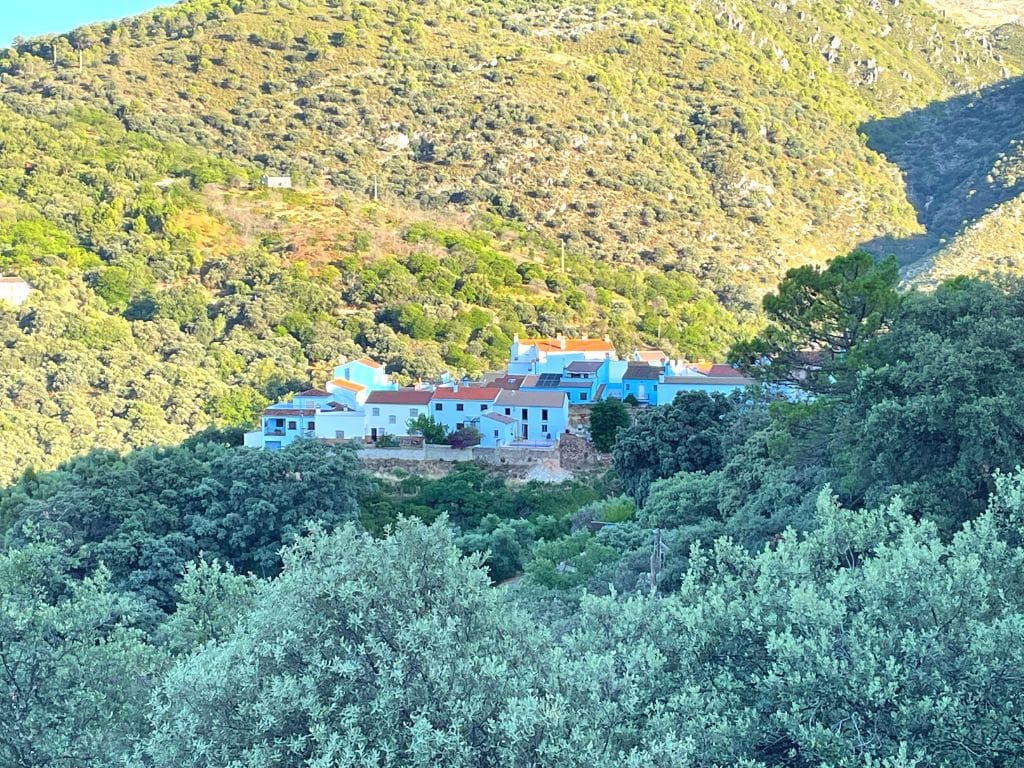
First things first, where is this legendary Smurf village?
Júzcar is a small town located in the eastern part of the province of Málaga in Andalusia, southern Spain.
More specifically, you’ll find it tucked away in the scenic Genal Valley within the Serranía de Ronda mountain range. With about 250 inhabitants, the village’s economy is mostly based on agriculture and tourism.
Only 15 miles (34 km) from Ronda, Spain, Júzcar makes a great stop when driving to or from Ronda. (Ronda is popular for day trips from the nearby Costa del Sol.)
Why is Júzcar blue?
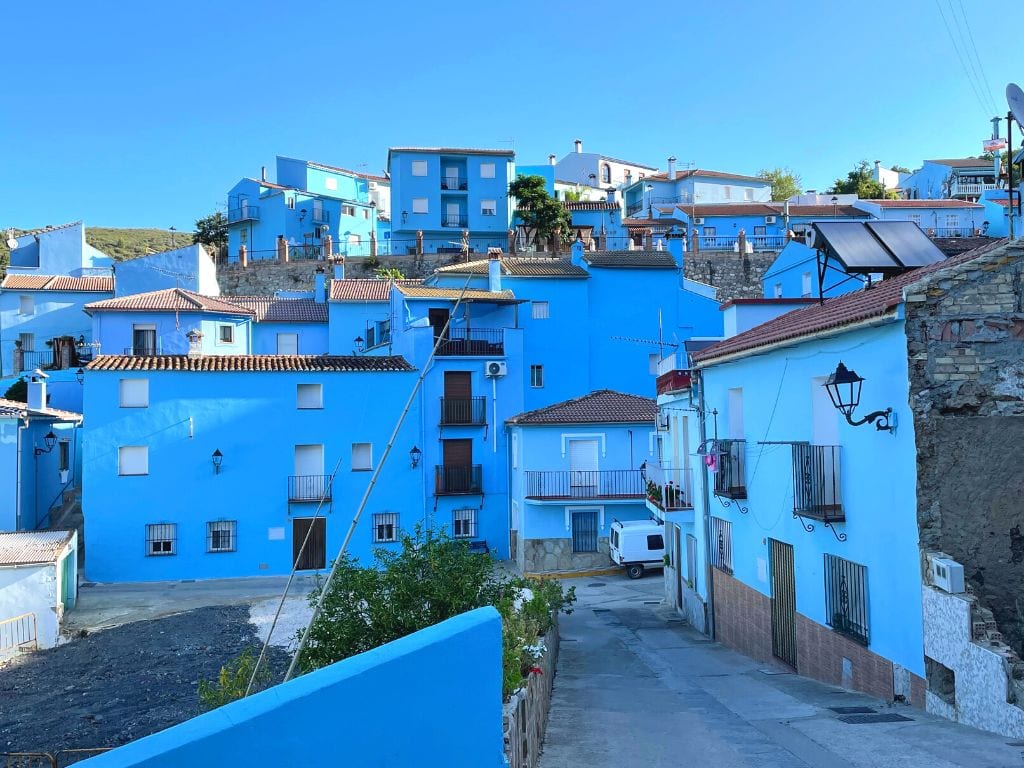
Up until 2011, Júzcar was one of Andalusia’s many traditional white villages (pueblo blancos). With hilly, narrow streets, balconies of flowers, agriculture, and some outdoor activities nearby, it didn’t see an abundance of tourism.
Things changed, however, when Madrid-based publicity agency Bungalow25 along with Sony Pictures approached the Júzcar with a unique proposition for the mushroom-loving town: to paint the town entirely blue for the premiere of “The Smurfs 3D” movie.
The town agreed, and 20 painters set out to transform Júzcar’s 175 buildings into a real-life Smurf village—complete with a blue town hall and blue church. The job took approximately 1,100 gallons (4,000 liters) of bright blue, eco-friendly paint.
The painting was completed over the summer in time for a special premiere on July 23, ten days before the movie’s official release.
Although the original agreement was for Sony to give Júzcar a fresh coat of white paint after the publicity stunt, Júzcar’s tourism increased rapidly. An estimated 50-90K tourists visited the Júzcar Smurf village in the 6 months following the event, whereas the village had previously seen about 9,000 guests annually.
Seeing this boost in tourism, Mayor David Fernández organized a special referendum in December 2011 to decide if the village should revert to white or remain blue. An overwhelming 80% of residents agreed that tourism was good for the town, and the buildings have been blue ever since.
Residents seemed to really take the Smurf theme to heart. New public services, businesses, and guesthouses have opened to meet the demand. Plus, residents have organized Smurf-themed events and competitions, a mural hunt, blue face or nail painting, and hat decorating, among others.
The village also hosted the first screenings of the Smurfs 2 and Smurf 3 movies, which undoubtedly gave another boost to its tourism.
Sadly, the blue village has seen some controversy which has changed things a bit. In 2017, the estate of Smurf creator, Belgian artist Pierre Culliford, filed a trademark complaint that required villages to pay 12% royalties on any Smurf-related income.
Due to copyright claims the village is now officially known as the blue town (La Aldea Azul) rather than the Smurf town. Many actual Smurf motifs are gone, although the mayor views this as a good thing: being a blue city is much more sustainable for tourism.
The 13 Best Things to Do in Júzcar, Spain
Despite its fame as a blue city in Spain, Júzcar is rather sleepy—like any other Andalusian town. With a few restaurants, shops, and points of interest, you can easily explore Júzcar in the afternoon.
While you’re there, here are the top things to do in Júzcar:
1. Júzcar Viewpoints
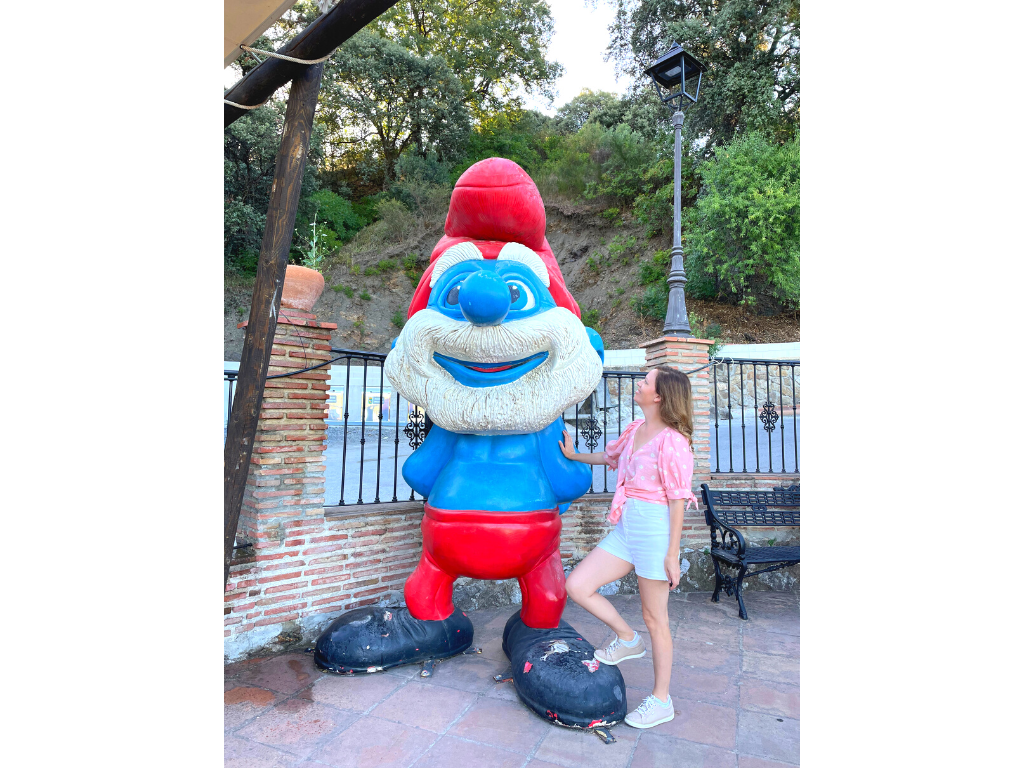
Owing to Júzcar’s picturesque setting, there are several amazing viewpoints around town that offer different perspectives of the city, valley, and surrounding mountains.
The Mirador de la Torrichela (where you can find a giant Papa Smurf) and Mirador el Jardon are easily accessible. In fact, you’ll see them as you walk into the city.
Tucked further away behind the church, the Mirador de los Molinos will give you a view of the valley behind the town. The Mirador de San José is also near the church.
If you follow the hiking path Sendero de los Molinos you will find Mirador del Nacimiento las Zúas along with a beautiful natural spring.
It should be noted that Júzcar is rather hilly. Come prepared with good shoes as you’ll have to do some walking. Fortunately, the views are worth the steep inclines and declines! Plus, you might find some Smurfs along your way!
2. Smurf Graffiti Route
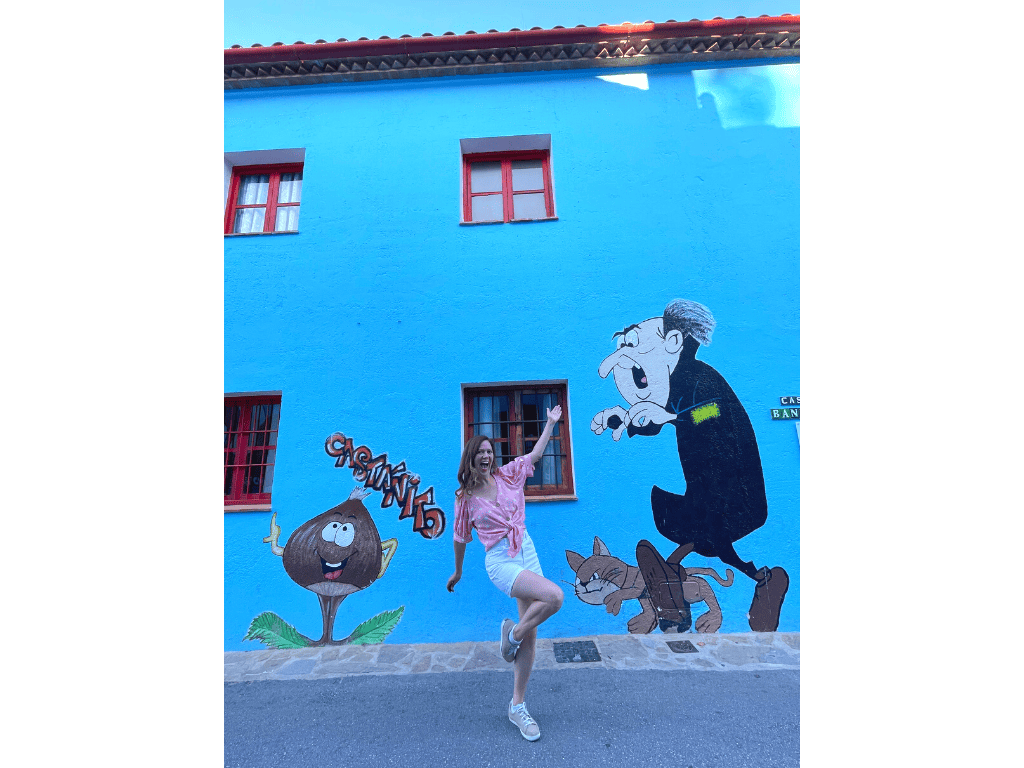
Júzcar is nothing if not Instagrammable. In fact, one of the best things to do in Júzcar is to take pictures in front of some of the fun murals around town. There are 14 different murals with whimsical drawings like mushrooms, flowers, and vines.
The Gargamel and Hotel Bandolero (giant mushroom) murals are right at the entrance to the village and therefore easy to find. But, some of the others are tucked away on the winding, hilly residential streets.
Thus, you can simply wander around and find the Instagram-worthy murals for yourself, or get a map at the tourist information office. If you find all 14 Smurf murals, you might even get a special surprise.
3. Parque de Júzcar
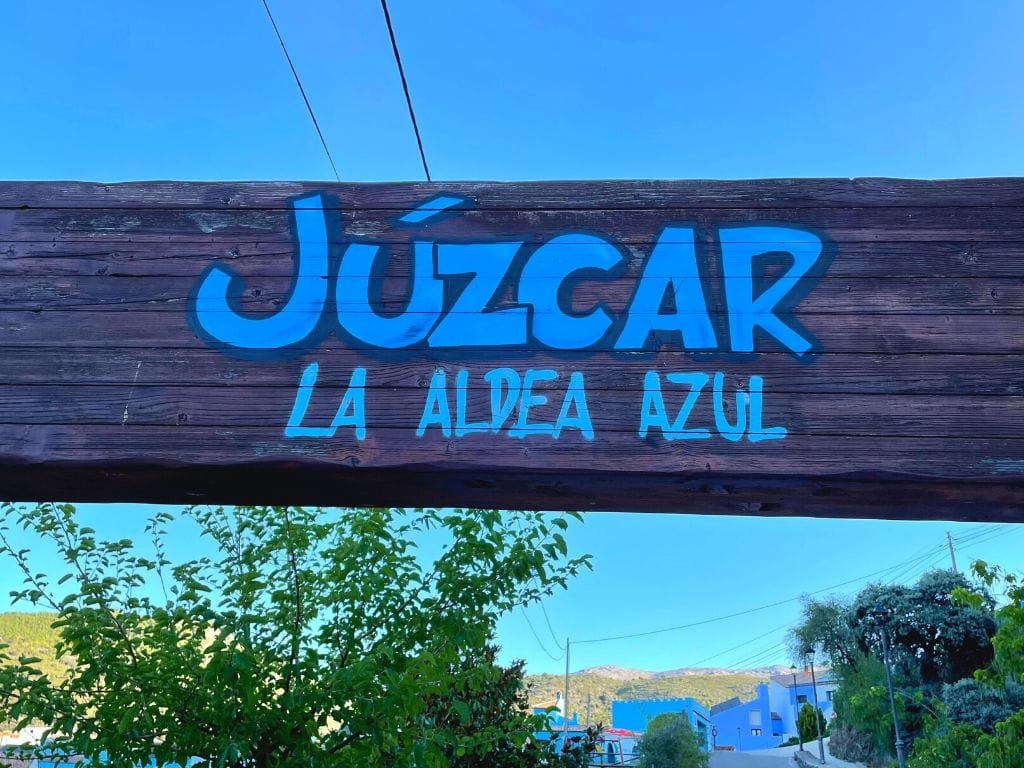
As soon as you arrive in town, you’ll see the Parque de Júzcar. This small children’s playground is great for kids, but adults can have fun, too. The motto “Don’t stop playing when you get older,” painted on a mushroom, reminds us all to find the joy in life at any age!
Play hide-and-seek behind a giant toadstool, go on a smurf or mushroom hunt, and enjoy the view from the park’s balcony.
4. Júzcar City Hall

Júzcar’s Ayuntamiento (city hall) contains the city’s municipal offices. The city appears to organize many local events for residents and is highly involved with ongoing tourism efforts.
Outside the building hangs a stone marker with the city’s heraldic shield. The shield tries to reflect the present and the past of Júzcar with references to the stone mills, trees, fountains, and medieval towers.
Be sure to snap a few photos outside of the impressive building.
5. Júzcar’s Church of Santa Catalina

Júzcar’s Iglesia de Santa Catalina of Siena was built in 1505. A smallish church with a single nave, it’s said to have been built on top of a former village mosque. The church itself has also been rebuilt several times, but the Mudejar-style belfry and part of the arch supporting the tower are original.
Behind the church, you’ll find a cemetery with above-ground crypts. Although I felt a little awkward as a tourist wandering around the maze of crypts, it was quite interesting to see. I quietly paid my respects before heading back out to the street.
The church and the graveyard have been re-painted white and now stand out among the sea of real-life Smurf houses.
6. Hiking Trails Near Júzcar
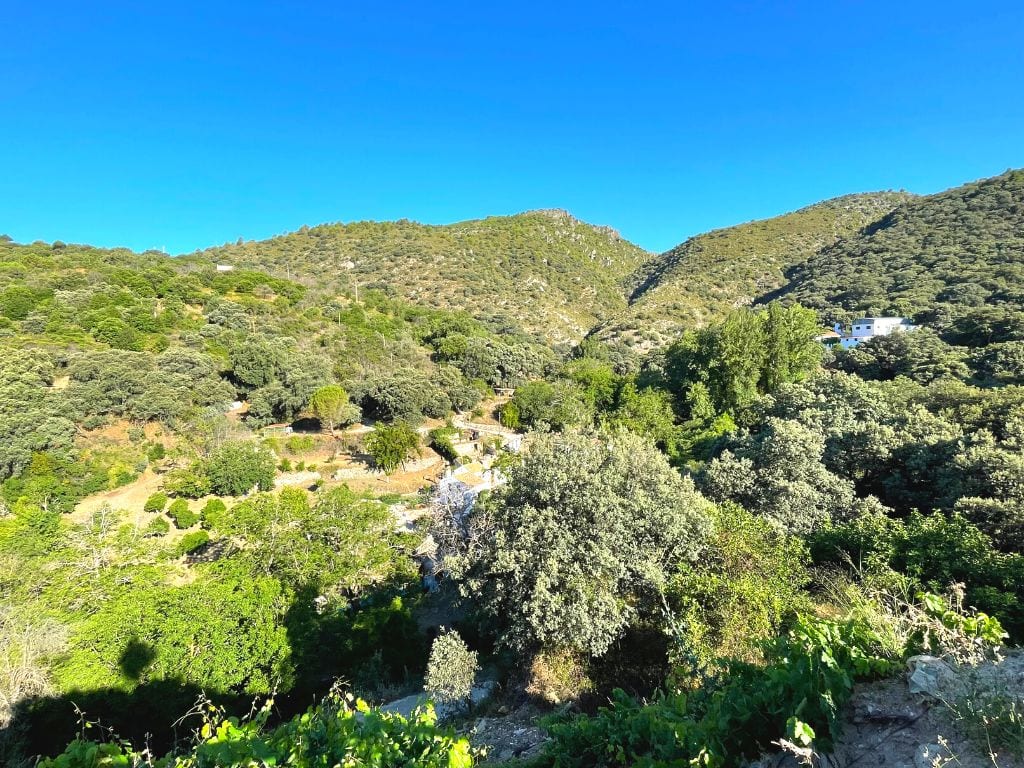
There are several hiking trails around Júzcar, three of which you can start from town.
These trails wind through the surrounding landscapes and vary in difficulty:
Ruta de los Molinos: The easiest trail on a day trip to Júzcar is the Los Molinos route. This is an easy-moderate circular route. At just 0.8 mi (1.28 km), you can complete the route in about 30 minutes.
Ruta Moclón: Embark on the Moclón hiking route, a 2.06 mi (3.23 km) out-and-back trail path (you can walk even further). Considered medium-low difficulty, the route offers stunning vistas as it winds towards Moclón, a ghost town. Begin on Calle Sol, where you’ll find a trail marker with the information and characteristics of the route.
Ruta de los Riscos: The Los Riscos route is the most challenging at 4.08 mi (6.57 km) and a medium-high difficulty. Expect some steep and demanding terrain. Experienced cyclists with high technical skills can tackle this route on MTB. Horseback riders should carefully consider their animal’s suitability for the steep and unstable conditions.
7. Júzcar Zipline
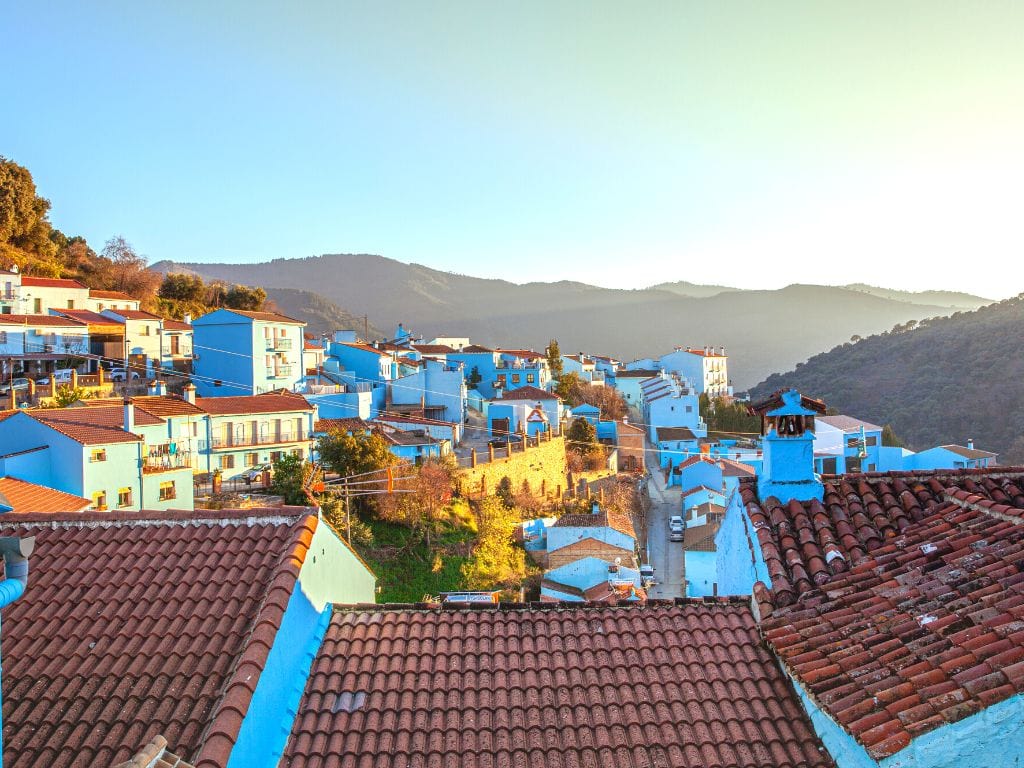
Júzcar has a small adventure route for those looking for a little rush of adrenaline—both for adults and children. The route includes two ziplines (both included for the price of one ticket) as well as some other small climbing walls, bridges, stairs, and other jumps.
The entrance to the zipline is located up the hill behind the Torricheli viewpoint. It includes two lines, the Villian and the Big Blue, which sail across the blue village and offer a once-in-a-lifetime view.
The Júzcar zipline is normally open on Saturdays, Sundays, and holidays from 11 am to 2 pm and 5-8 pm.
8. Mushroom Museum
If you wonder why Sony Pictures chose this Andalisuan village from all the others for the publicity stunt, it’s partly because Júzcar has a long tradition of mycology. (If you remember, the Smurfs are especially known for their love of mushrooms).
To learn a little more about mushrooms and their importance in Júzcar, stop by the Centro cultural, turístico y micológico. It has a small exhibition and a cultural information center.
9. Birdwatch in Júzcar
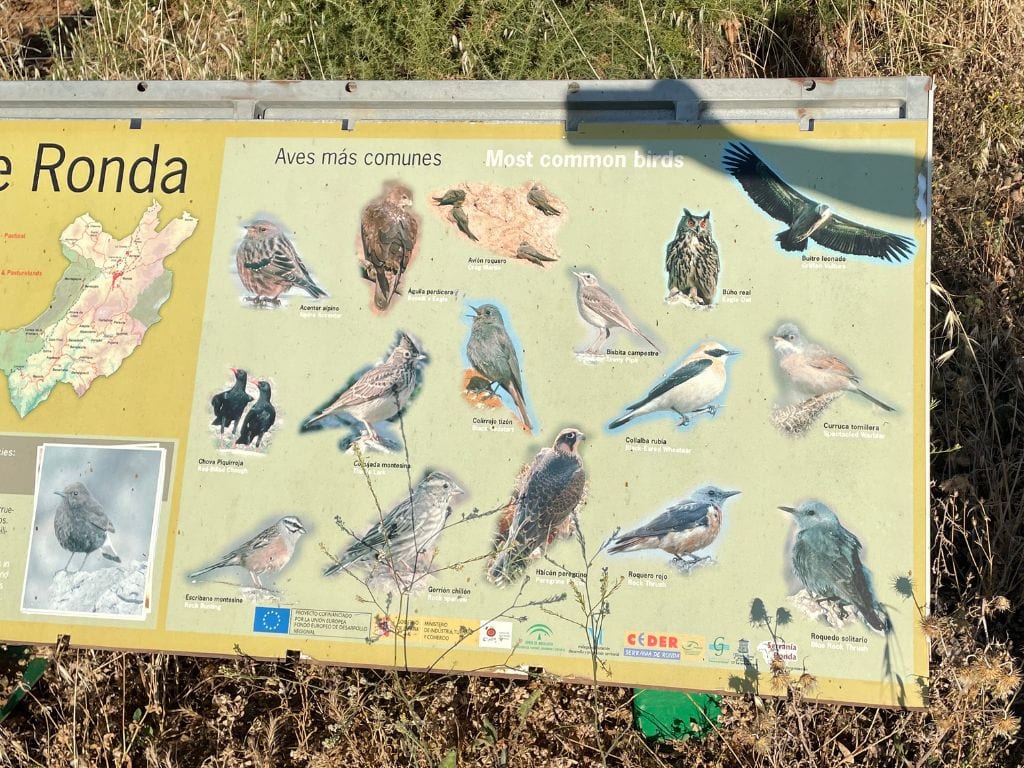
The Serranía de Ronda is a birdwatcher’s dream, and Júzcar is no exception. Due to the variety of terrain within the county (mountains, forests filled with pine and chestnut trees, riverbeds, etc.), you can spot many different types of birds throughout the year.
Here are some common birds you might be lucky enough to see in Júzcar: vultures, eagles, buzzards, partridge, eagle owls, bee-eaters, thrush, warblers, and buntings.
10. Shopping in Júzcar
If you’d like to do some souvenir shopping, there are a couple of little shops in town. Check out the local products made from straw or cork like espadrille sandals, baskets, or jugs. You can also pick up some local meat, cheese, or wine to enjoy later.
Note that store opening hours are sparse, so don’t get your hopes up when it comes to shopping in Júzcar!
11. Tourist Information Center

There is a tourist information booth right at the entrance to the village. After you park, stop here to get a map and more information about what to do and how to get around town.
The tourist information point is typically open on Saturdays, Sundays, holidays, and long weekends from 10 am to 3 pm and 4-5 pm.
12. Fountains & Springs

Throughout the town, you can find various natural water fountains. The Almachar Fountain is just opposite the tourist information booth, for example.
The fountains have a coat of blue Smurf paint, just like the rest of the town. You can find informational posts outside most of the fountains and a sign indicating if the water is potable.
The most impressive water source is the Nacimiento la Zúa, 0.25 mi (0.4 km) outside of town.
13. La Antigua Real Fábrica de Hojalata San Miguel
La Antigua Real Fábrica de Hojalata San Miguel was the first tin plate factory in Spain. Built in the 18th century, the factory fell into disrepair but much of it has been beautifully restored and is now used as a winery. You may tour the winery to learn about traditional wine-making methods and natural wines or simply enjoy a view of the vineyards on a hike.
What & Where to Eat in Júzcar
During your stay, plan to try one of the typical restaurants, bars, or cafes serving local specialties.
What to Eat in Júzcar
As for local gastronomy, Júzcar is known for its use of seasonal and local products. Stews are common as is the use of mushrooms, wild herbs, asparagus, rabbit, and pork sausages.
Try these typical dishes in Júzcar:
- Order some of the mushrooms, but also the garlic sprouts and joints, and other wild herbs, often prepared in a scrambled egg dish (revueltos).
- When you’re in the mood for hot food, taste the famous soup called sopeao de collejas, made with a little-known herb of the same name. Rabbit with garlic (conejo al ajillo) and migas, a dish with bread, sausage, melon, olives, and other available local vegetables, are also popular.
- When it comes to treats, borrachuelos (fried donuts made with wine), twisted bread (torcidos) and fried pastries (roscos and buñuelos) are key.
- To drink, order a local must wine (vino mosto) or artisan beer.
- Chestnut products are also worth trying.
Júzcar Restaurants
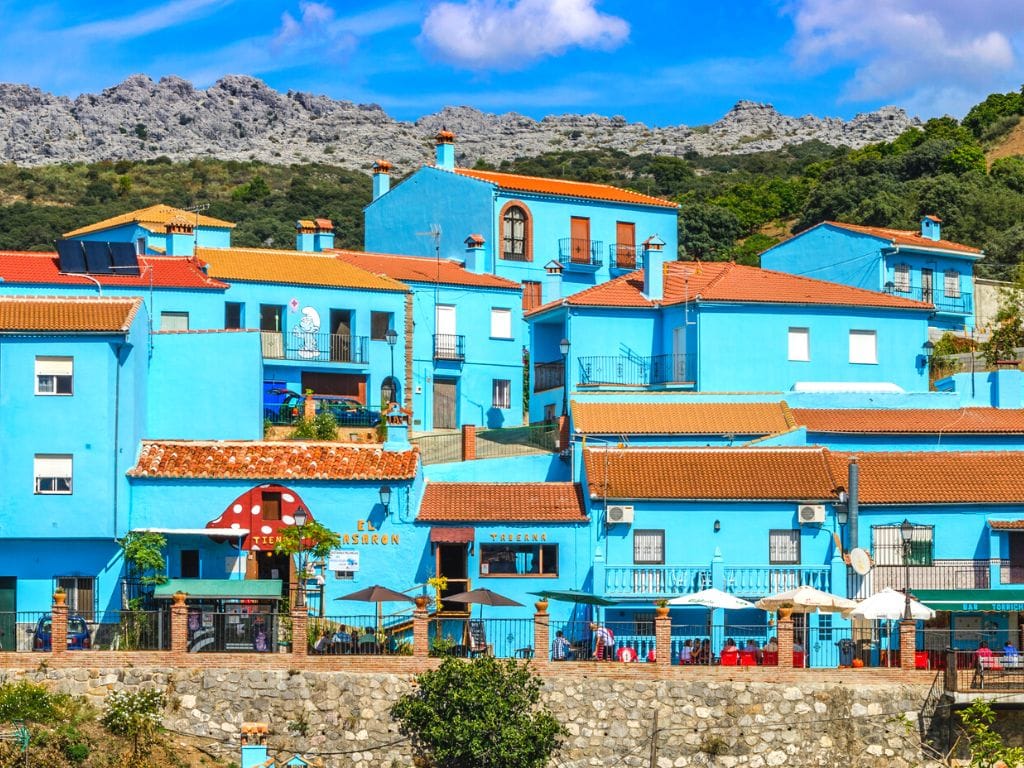
Júzcar is a quiet town, but there are a few restaurants in town where you can try the local gastronomy and enjoy the view. Opening hours may vary by season.
Here are the best restaurants in Júzcar:
- Bar y Tienda El Casarón: Tapas bar right in the center of town offering artisanal beer, local wine, and a seasonal menu. They also have a small store where you can buy meats, cheeses, and other specialties of the region.
- Restaurante La Bodega del Bandolero: Great restaurant serves flavorful food and desserts in creative combinations. For something really special, try the suckling pig and backed chestnut cream for dessert.
- Bar Parriba Pabajo: Simple bar with local products, homestyle cooking, breakfast, and snacks.
- Bar Torricheli: Great for coffee and toast in the morning or local plates and tapas later in the day. Right near the top of the Torricheli viewpoint, meaning it has great views of the village.
How to Get to Júzcar
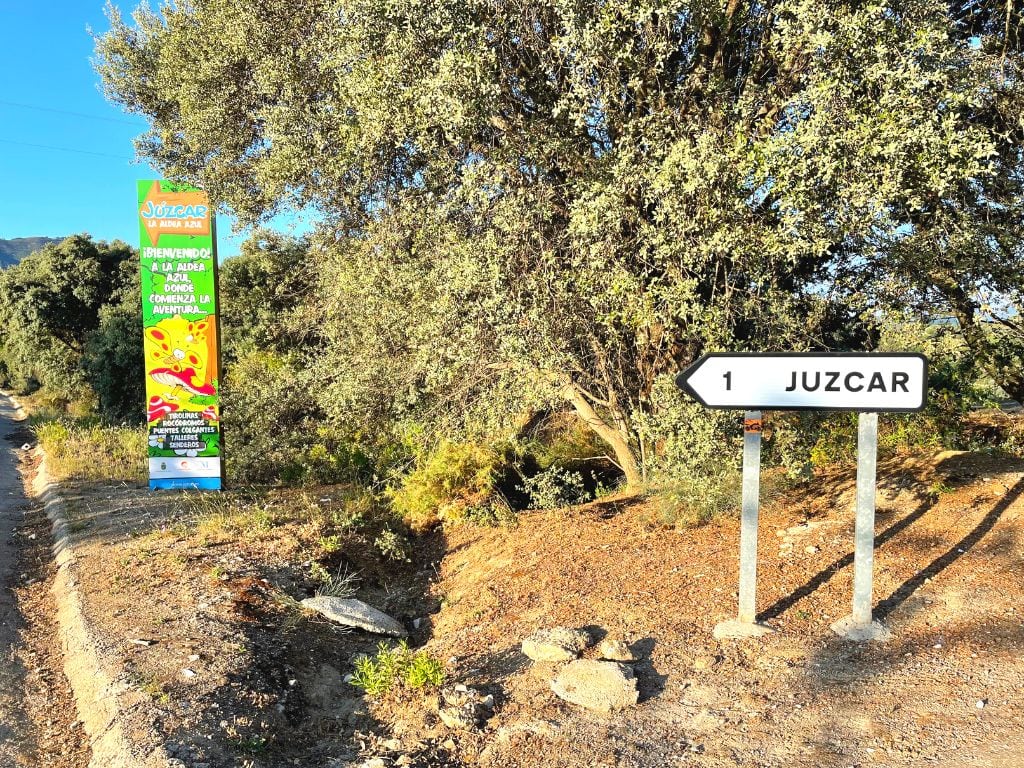
The easiest way to get to Júzcar is by car. Júzcar is located about 1 hour and 45 minutes from Málaga, 1 hr 10 mins from Marbella, and just 30 minutes from Ronda.
From all three cities, make your way to the A-397. Then turn west onto MA-7306 towards Júzcar. (MA-7306 will turn into MA-7303.)
The drive to Júzcar along the mountain road (marked MA) is breathtaking. However, do be mentally prepared as you drive into the valley. The road is a windy, one-lane road with several blind curves along the side of the mountain. Drive slowly, as you may need to pull to the side of the road to let others pass.
Need a rental car for your trip to Júzcar? Check availability, and reserve a rental car on Discover Cars using the form below! ⬇
When you get closer to Júzcar, you’ll see the roads Calle Los Riscos and Calle Solete. Although you may be tempted to turn on them, please avoid doing so as they are very steep and narrow. The town has marked them as Solo residentes (Residents only).
Instead, continue along MA-7303 past the Júzcar welcome signs, and you will come upon the main entrance to the town.
As soon as you arrive at the entrance, you’ll find ample free parking to your left. Find a spot, and continue your adventure into the pueblo azul (blue village) on foot!
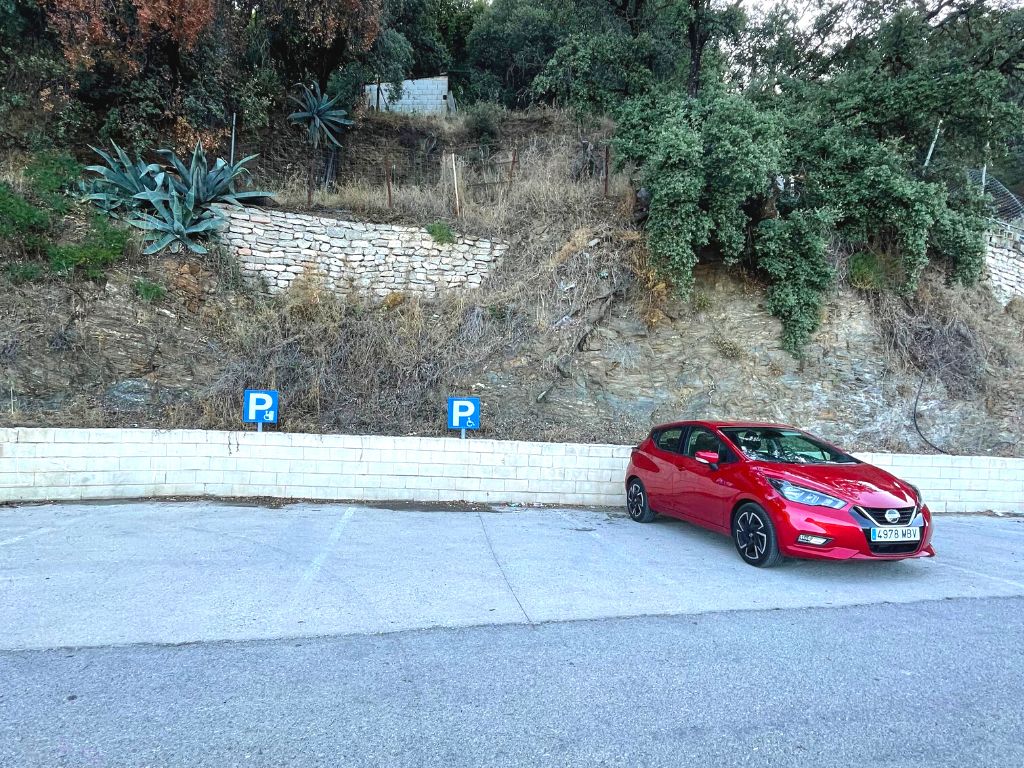
Where to Stay in Júzcar, Spain
Due to the demand for tourism, there are now more options for staying a night or two in Júzcar.
Best Hotel in Júzcar: Hotel Restaurante Bandolero
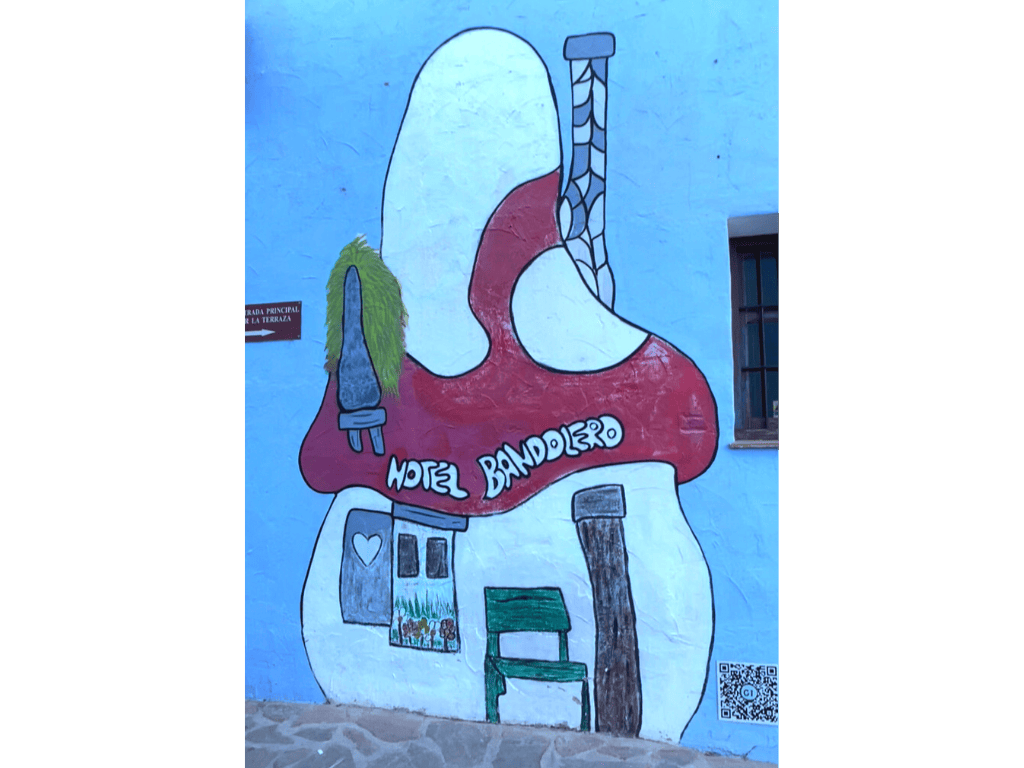
If you’d like to spend a night in Júzcar, Hotel Restaurante Bandolero is the best hotel in Júzcar. A charming boutique hotel with 8 comfortable rooms, it’s right near the entrance to the city for ease of access.
Each room boasts rustic furniture, a fireplace, and a terrace with mesmerizing mountain views—all designed to help you embrace the tranquility of Júzcar, Andalusia, Spain and its natural surroundings.
Managed by welcoming owners David and Iván, this lodging also houses a popular restaurant, La Bodega del Bandolero. Here, savor tapas, homemade desserts, and creative dishes crafted from locally-sourced ingredients.
Hotel Bandolero in Júzcar also offers an outdoor pool (seasonal) and will point you in the direction of smurf hunting, horse riding, cycling, and hiking opportunities in the picturesque countryside.
Other Places to Stay in Júzcar
In addition to the hotel, several apartments and country homes are available to rent. Rates are typically higher than the hotel but may be a good option for groups.
Here are the top options for vacation rentals in Júzcar:
- Casa el Genal: Four-bedroom house with a terrace in a tranquil central location.
- La Casa del Bandolero: Three-bedroom townhouse with terrace near city entrance.
- Apartamentos Real Fábrica Hojalata: Apartment with city views; near the parking lot.
- Casas Rurales Júzcar Centro: Country house just outside of central Júzcar with a pool.
- Casa Rural Molino de Bony: Spacious vacation home with a pool and mountain views near the riverbed, just before the Mirador del Nacimiento las Zúas.
Best Time to Visit Júzcar: Weather & Festivals

Júzcar has a mild Mediterranean climate with warm, dry summers and mild winters making it practically a year-round destination. Generally, spring and late fall are considered the best times to visit due to pleasant weather conditions and festivities that take place.
Spring is Júzcar sees warmer temps and plenty of visitors for the Holy Week festivities. In fact, in April 2023, the village saw 11K tourists during Holy Week! Peak prices begin around March-May as well.
Summer in Júzcar sees up to 10 hours of sun, which gives plenty of daylight for exploring. Plus, even the hottest months of July and August only see temperatures around 86 °F (30 °C). The Fiesta de la Virgen de Moclón, honoring the patron saint of the village, is held during August.
Hotel prices will drop in the fall along with the weather, but it typically stays pretty nice into November (highs in the 50/60’s °F/14-19 °C). However, it does start to get rainy in November, on average. The Valle del Genal Mycological Days are also held each November during the mushroom season. Chestnuts are also harvested during this time, offering some interesting activities to participate in.
Winters are mild, with average temperatures in the high 40’s (6-7 °C). However, the town sees the most rain during this time (Nov-Feb). Do note that Júzcar may be closed in January for the holidays. It’s best to avoid booking during this time.
Júzcar Map
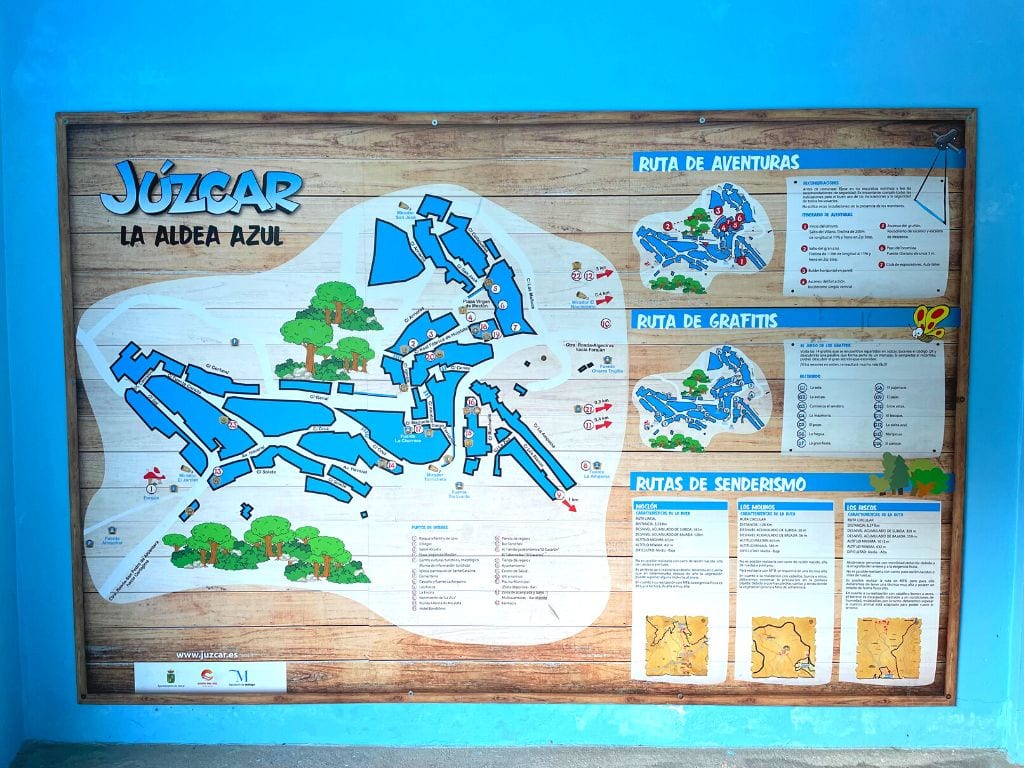
You can download a map of Júzcar here. You’ll also find a map at the tourist information office as well as signs all around town to point you in the right direction.
History of Júzcar
Júzcar played a significant part in the region’s history. However, since accounts of the ancient settlement are scarce, this history is limited to the Moorish period. An Ibertian hill fort suggests the Júzcar area was inhabited during the Bronze Age and founded by the Moors. It would have acted as an important center for many of the smaller nearby communities.
After the Christian conquest in 1485, Júzcar, like many other villages in Andalusia, witnessed the expulsion of the Moors and subsequent repopulation. The parish church of Santa Catalina was erected soon after, very likely on top of a fallen mosque.
The city then became a Mozarabe community (Christians who adopted the Arab language and customs but resisted conversion to Islam) and witnessed an additional period of turmoil.
Things were looking up in the 18th century as Industry thrived and the first tin factory was established in Júzcar. However, the decline of the mining and milling industries brought its own set of economic challenges.
The Peninsular War and Napoleonic invasion brought additional instability. By the early 20th century, Júzcar’s fortunes had all but disappeared. Most employment was then seasonal agriculture.
Despite its ups and downs, Júzcar has continued to evolve. Today, its vibrant history evokes a sense of local pride. It also embraces its status as Spain’s magical blue village with plenty of nature tourism to enjoy as part of ongoing revitalization efforts.
Júzcar, Spain FAQ
Is Júzcar still blue?
Yes, Júzcar is still blue. Once the promotion of the Smurfs movie had passed, the inhabitants of Júzcar decided to keep the buildings painted blue to take advantage of their newfound tourism boom. In fact, the Spanish village has been painted blue 4 times since 2011, twice by Sony Pictures and twice by the residents themselves. Local and provincial municipalities are now committed to supplying the bright blue paint!
What is the blue town in the south of Spain?
The name of the Smurf village in southern Spain is called Júzcar. It’s known as the Smurf Village in Spain (El Pueblo Pitufo) by locals and officially as the Blue Village (La Aldea Azul). Even though it’s tiny, Júzcar makes for a memorable stop on a road trip through Andalucia!
What is the meaning of Júzcar?
Júzcar is a small village in the province of Málaga, Andalusia in southern Spain. The name Júzcar, terminating in -ar, suggests a long history of Arab invaders, Romanised Iberians, and/or Visigothic peoples.
How do you pronounce Júzcar?
Júzcar pronunciation in Spanish is ˈxuθkaɾ. It sounds like “hoos-kar.”
Are there any festivals in Júzcar, Spain?
Yes, there are several annual celebrations in Júzcar. On March 19, the Day of San José is observed. During Holy Week, many festivities are held, including the “El Huerto del Niño,” a tradition in which villagers build a pine hut. The third week of August, the villagers celebrate the patron saint, Virgen del Moclón with various activities for townspeople and visitors alike.
Why did Sony choose Júzcar?
Júzcar, Spain wasn’t selected for the Smurfs movie promotion partly because it was already known for mushrooms. Each fall, the delectable fungi are harvested and celebrated in the village in a series of festivities. If you remember the cartoons, Smurfs love mushrooms and even live in them! Thus, it made sense for Júzcar to bear the name, “the world’s first Smurf village.”
What are Smurfs called in Spanish?
Smurfs are called Pitufos in Spanish.
What are people who live in Júzcar called?
People who live in the village of Júzcar, Spain are called Júzcareños in Spanish.
What else is there to do near Júzcar, Spain?
Júzcar is a good base for outdoor activities like hiking, canyoneering, ziplining, and cycling. The Route of Fray Leopoldo, “the most revered saint in Andalusia,” is also nearby. This 7.8-mile (12.6 km) trail between Jimera de Líbar and Alpandeire follows the footsteps of the “Blessed” and allows you to pass through some of the most scenic parts of the Serranía de Ronda. If you visit in the spring or early summer, you might catch the daffodils and white rockrose in blooms among the many almond trees in the forest.
Is it easy to get from Ronda to Júzcar?
Yes, it’s very easy to get from Ronda to Júzcar as the blue hamlet is located about 30 minutes south of Ronda by car.
Where do people visit Júzcar from?
The majority of Júzcar’s national visitors are from Andalusia, Madrid, Catalonia, or the Basque country. Interestingly, foreigners are mostly from Turkey, Slovakia, Portugal, France, Belgium, and the U.K. (You’ll notice whenever you visit the tourist information centers in Andalusia, they always ask you where you’re from for statistics.)
Is the Blue Village in Spain Worth Visiting?

Yes, the blue village is worth visiting!
From taking pictures in front of the murals to sampling the region’s gastronomy, there are plenty of things to do in Júzcar to make it worth a short day trip.
Plus, there are ample outdoor activities in the nearby area from hiking to canyoneering, horseback riding, cycling, and more.
However long you visit, there’s no doubt you’ll have fun checking out Spain’s blue Smurf town and trying to answer the age-old question, “Are Smurfs real?!”
